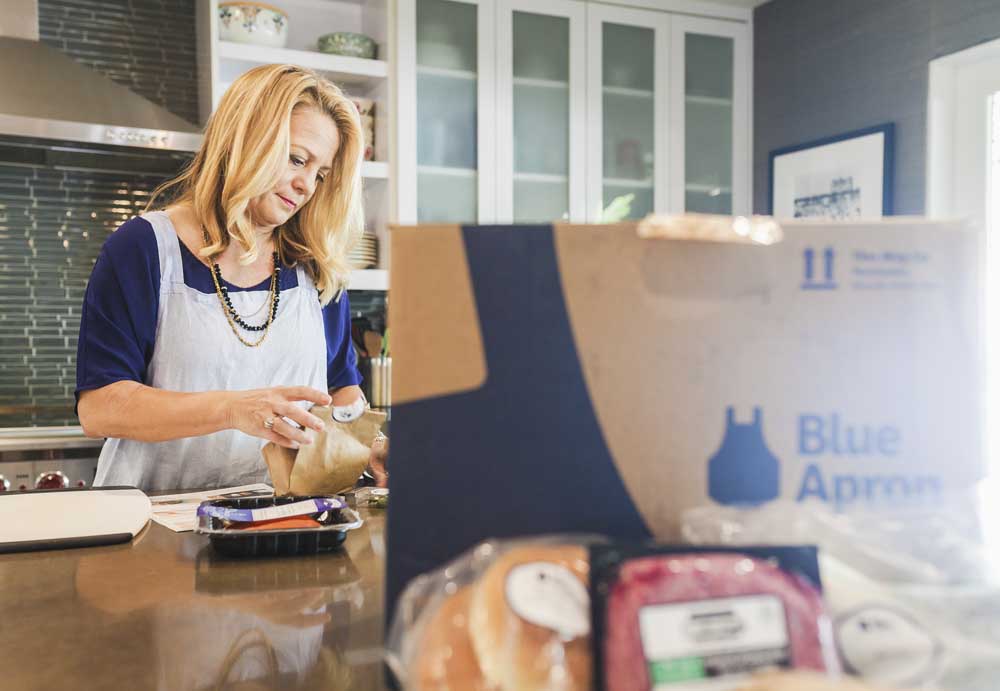Meal kits: changing cooking culture
Published 12:00 am Wednesday, April 6, 2016

- Oriana Koren / The New York TimesJennifer Freed unpacks a Blue Apron meal kit at her home in Los Angeles last month.
If you drew up a list of people likely to hate home-delivered meal kits like Blue Apron, Sara Moulton would be on it. She is one of the nation’s most enduring recipe writers and cooking teachers, a former food stylist for Julia Child and a dean of food television and magazines in her own right, whose new book is called “Home Cooking 101.”
But after two meal kit companies approached her to work with them, Moulton thought she should investigate. As for anyone who has been paying attention to home-cooking trends, it was hard not to be at least a little meal-kit curious. So she signed up.
Trending
“I have to say, I was very pleasantly surprised,” she said, echoing the sentiment of many very good cooks who have taken the plunge and ordered a box.
Moulton has not decided whether she’s going into business with one of the companies, but the kits gave her ideas for recipes. And the best part? She didn’t have to decide what to cook for dinner.
“Making dinner every night really wears thin,” she said. “You bore yourself. Even me.”
In the span of a few short years, more than 100 companies have jumped into the meal-kit game. Millions of cardboard boxes arrive on urban and rural doorsteps every month, holding everything one needs to cook dinner, down to the rice wine vinegar and panko.
Ingredients are packaged in exact proportions, ready to be chopped or sauteed according to well-illustrated recipe cards. In less than an hour, even a mediocre cook with salt, pepper and cooking oil can produce an Instagram-worthy meal.
Technomic Inc., a food industry analyst, predicts that at the current rate of adoption, the U.S. meal-kit market could grow by as much as $5 billion during the next decade. Blue Apron, the company that has emerged as the Starbucks of the meal-kit business, said it now ships 8 million meals a month.
Trending
“We’re still a tiny percentage of the overall home cooking world,” said Matt Salzberg, the chief executive of Blue Apron, adding that the company is making money on every shipment. “We don’t know why Blue Apron wouldn’t have a place in every home in America in some way.”
Some analysts say meal kits show classic signs of a bubble that may already be leaking air. They make comparisons to the rise and fall of the grocery delivery service Webvan in the first wave of the tech boom, or meal assembly storefronts, where cooks pick recipes online and then show up to put together what are essentially fancy casseroles from precut ingredients. Such companies once opened at a rate of 40 a month in the early 2000s but have faded from view.
Others say this is different. Like frozen foods or the microwave oven, meal kits may be a kitchen innovation that fundamentally changes how people cook at home.
“Bagged lettuce seemed like a fad, too,” said Jenny Zegler, the global food and drinks analyst for the research company Mintel.
Meal kits seem to have arrived at just the right moment, burrowing deep into the everyday life of a digitally fluent nation whose tastes have been honed on restaurant meals, farmers markets and food television. The kits appeal to people eager to learn more about cooking with chickpea flour or organic escarole but less enamored with their procurement.
“There is a feeling of a lack of accomplishment, especially among millennials who feel like it’s a solid effort just to get frozen ravioli cooked and a bagged salad together,” said Melissa Abbott of the Hartman Group, which researches eating patterns. “They say these meal kits are teaching them how to cook so they can participate in the conversation and feel empowered.”
Michael Pollan, the author whose book “Cooked: A Natural History of Transformation” has been turned into a documentary now streaming on Netflix, counts meal kits as a positive development in cooking culture.
“They are teaching very valuable lessons to people,” he said. “Whether this is a step in a process or an enduring solution to a problem, I don’t know the answer to that.”
Mark Bittman, the cookbook author, left his job as a New York Times columnist in 2015 to join the vegan meal kit company the Purple Carrot, which started in California a year earlier. The first shipment consisted of 93 boxes. Now, the company ships tens of thousands of meals from distribution centers in Los Angeles and New York.
“It is cooking,” Bittman said. “It’s not shopping, and it’s not planning. And, in a way, it’s not thinking. But it is cooking.”
He said he could not predict the financial viability of the concept, or whether it’s a steppingstone on the path back to cooking or a permanent part of the kitchen.
“I don’t think it’s a bubble in the sense that it’s going to blow up and not exist anymore like the first dot-com thing,” Bittman said. “It may be that if you join our meal-kit company and then you learn how to cook and then you don’t need a meal kit anymore, we are a great company.”
The delivery of precurated ingredients is not going away, he and others say. Grocery stores are trying to figure out how to get in the game, and although there are three big meal-kit players on the national scene, the regional variations are, by some estimates, more than 100 and growing, each seeming more specialized than the one before.
If you want dinner built largely from food grown by Georgia farmers and recipes from Southern chefs, subscribe to PeachDish, which ships nationwide. If you live in Boston and prefer to avoid cross-country shipping, join Just Add Cooking and get boxes built with a New England sensibility and delivered by local courier. Devotees of the culinary sensibilities of Northern California can join Sun Basket, where one of its owners, Justine Kelly, the former chef de cuisine at Charles Phan’s Slanted Door in San Francisco, develops the recipes.
She wrote 450 recipes last year and each month sends out about 150,000 meals including lemongrass- and coriander-crusted pork loin and coconut-almond breakfast smoothies. The price works out to about $11.49 a meal, which she admitted makes it a luxury item for some. But Kelly said she has friends who are not wealthy who use it because the time-cost ratio works in their favor.
“Honestly, especially in the Bay Area, it can be cheaper to do a meal kit than shop,” she said.
Costs can drop to about $9 or $10 a meal with some services, but Moulton said that is still a lot for some people.
“I just don’t think it’s sustainable for the general population,” she said.
Meal kits have also become serious currency in the cross-branding world, with chefs and companies lending their names and recipes. The leader is Chef’d in El Segundo, California. Unlike most meal kit companies, it does not require a subscription.
Chef’d has partnerships with 84 chefs and companies. Among them are The New York Times and the Crown Publishing imprints Clarkson Potter and Ten Speed Press, which provide recipes the Chef’d culinary team packages into meal kits.
For $59, you can cook spiced, honey-glazed duck for four by the San Francisco chef Dominque Crenn. For $29, two people can have miso-glazed cod vetted by Weight Watchers and guaranteed to cost you only 7 points on the company’s weight-loss plan.
Andrea Nguyen, a cookbook author, provided Vietnamese and dumpling dishes to Chef’d. Still, she is not enamored with meal kits because they do not provide the human contact and pleasure that come from hunting for ingredients and exploring the market.
“Cooking is a whole sociological thing,” she said. “I even like talking to the cashiers.”
On a deeper level, relinquishing so much to a company guts the essence of what it means to cook, said Laura Shapiro, a culinary historian who writes about modern cooking in the United States.
“Eating the food cooked by your own hand from your own family and traditions are the things that constitute our emotional life with food,” she said. “I can’t imagine we are going to look back and say, ‘Oh, remember that Blue Apron Burmese curry we used to have on Thursdays?’ It’s not the same. It’s not ours. It doesn’t have our family sentiments behind it.”








